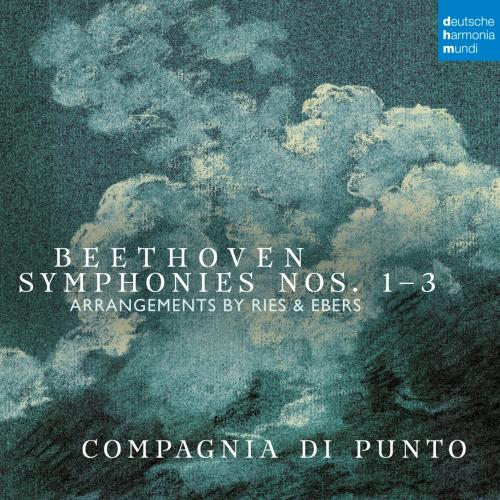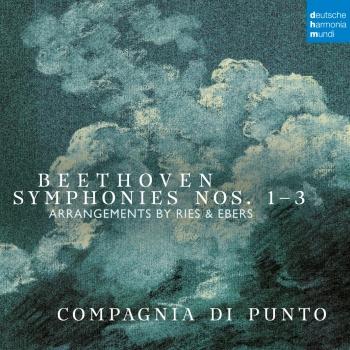
Beethoven: Symphonies Nos. 1-3 (Arr. by Ries & Ebers) Compagnia di Punto
Album info
Album-Release:
2020
HRA-Release:
28.02.2020
Label: deutsche harmonia mundi
Genre: Classical
Subgenre: Chamber Music
Artist: Compagnia di Punto
Composer: Ludwig van Beethoven (1770–1827)
Album including Album cover Booklet (PDF)
I`m sorry!
Dear HIGHRESAUDIO Visitor,
due to territorial constraints and also different releases dates in each country you currently can`t purchase this album. We are updating our release dates twice a week. So, please feel free to check from time-to-time, if the album is available for your country.
We suggest, that you bookmark the album and use our Short List function.
Thank you for your understanding and patience.
Yours sincerely, HIGHRESAUDIO
- Ludwig van Beethoven (1770 - 1827): Symphony No. 1 in C Major, Op. 21:
- 1 Symphony No. 1 in C Major, Op. 21: I. Adagio molto - Allegro con brio (Arr. for Small Orchestra by Carl Friedrich Ebers) 08:35
- 2 Symphony No. 1 in C Major, Op. 21: II. Andante cantabile con moto (Arr. for Small Orchestra by Carl Friedrich Ebers) 06:33
- 3 Symphony No. 1 in C Major, Op. 21: III. Menuetto. Allegro molto e vivace (Arr. for Small Orchestra by Carl Friedrich Ebers) 03:14
- 4 Symphony No. 1 in C Major, Op. 21: IV. Adagio - Allegro molto e vivace (Arr. for Small Orchestra by Carl Friedrich Ebers) 05:21
- Symphony No. 2 in D Major, Op. 36:
- 5 Symphony No. 2 in D Major, Op. 36: I. Adagio molto - Allegro con brio (Arr. for Small Orchestra by Ferdinand Ries) 10:41
- 6 Symphony No. 2 in D Major, Op. 36: II. Larghetto (Arr. for Small Orchestra by Ferdinand Ries) 09:21
- 7 Symphony No. 2 in D Major, Op. 36: III. Scherzo. Allegro (Arr. for Small Orchestra by Ferdinand Ries) 03:37
- 8 Symphony No. 2 in D Major, Op. 36: IV. Allegro molto (Arr. for Small Orchestra by Ferdinand Ries) 05:58
- Symphony No. 3 in E-Flat Major, Op. 55, "Eroica":
- 9 Symphony No. 3 in E-Flat Major, Op. 55, "Eroica": I. Allegro con brio (Arr. for Small Orchestra by Ferdinand Ries) 15:18
- 10 Symphony No. 3 in E-Flat Major, Op. 55, "Eroica": II. Marcia funebre: Adagio assai (Arr. for Small Orchestra by Ferdinand Ries) 12:21
- 11 Symphony No. 3 in E-Flat Major, Op. 55, "Eroica": III. Scherzo. Allegro vivace (Arr. for Small Orchestra by Ferdinand Ries) 05:24
- 12 Symphony No. 3 in E-Flat Major, Op. 55, "Eroica": IV. Finale. Allegro molto - Poco andante - Presto (Arr. for Small Orchestra by Ferdinand Ries) 11:05
Info for Beethoven: Symphonies Nos. 1-3 (Arr. by Ries & Ebers)
Wie ihre sechs Geschwisterwerke gehören auch seine ersten drei Sinfonien zu Ludwig van Beethovens bedeutendsten und bekanntesten Orchesterkompositionen. Auf diesem Album spielen aber statt eines großen Orchesters gerade einmal zehn Musiker diese Repertoire-Klassiker: Das rheinische Originalklangorchester Compagnia di Punto präsentiert als Weltersteinspielung Beethovens Sinfonien Nr. 1,2 und 3 in Bearbeitungen für Kammerorchester, die aus der Feder zweier Beethoven-Zeitgenossen stammen. Es waren der Beethoven-Schüler Ferdinand Ries (1784-1838) und der Komponist und Kapellmeister Carl Friedrich Ebers (1770-1836), die die Sinfonien Nr. 1-3 für kleine Besetzung einrichteten. Solche zeitgenössischen Bearbeitungen von großen Orchesterwerken ermöglichten es, Beethovens Musik auch in kleineren Salons zu spielen und bekannt zu machen. Von Carl Friedrich Ebers stammt die 1809 gedruckte Bearbeitung der 1. Sinfonie für nun zwei Violinen, zwei Bratschen, Bass sowie jeweils zwei Klarinetten und Hörner. Ferdinand Ries richtete um 1807 die Sinfonien Nr. 2 und 3 ebenfalls für doppeltbesetzte Violinen und Bratschen sowie u.a. für Flöte und Hörner ein. Diese Kammermusik-Fassungen werfen nicht nur ein intimeres Licht auf die drei Sinfonien, sondern garantieren zudem völlig neue Klangfarben und Klangdialoge zwischen den einzelnen Instrumenten. Eine wertvolle Entdeckung für das Beethoven-Jahr 2020.
Compagnia di Punto
Compagnia di Punto
For time immemorial, flutes, horns and strings have conveyed what words cannot express. As an ensemble, tranverse flute, natural horn and strings cover the entire orchestral range – an orchestra en miniature. Compagnia di Punto presents this unique timbre in various instrumentations from quintet to chamber orchestra.
The musicians’ individual histories began in Asia, in America and in Europe; in megacities, between coal dumps, in cultural centres and in the endless expanses of forests and oceans. The foundation of their common history was laid in Cologne’s Early Music circles: in leading positions of outstanding ensembles, each of them has built up an international reputation as an artist and teacher. Today they are active as soloists, chamber musicians, conductors, university teachers or lecturers at various European and overseas academies.
Compagnia di Punto's fundamental concern is to reveal the timeless qualities of Early Music in this day and age. According to the ensemble’s understanding, every concert program tells a story. So as to fathom these stories in their full depth and all their ramifications, the musicians trace back the music to its archaic roots and place it into new and often surprising contexts, in some cases also reflecting it in the light of contemporary compositions. Compagnia di Punto thus develops new narrative concert formats of dramaturgical design, breaking up formal barriers and linking music to literature and drama.
Booklet for Beethoven: Symphonies Nos. 1-3 (Arr. by Ries & Ebers)










